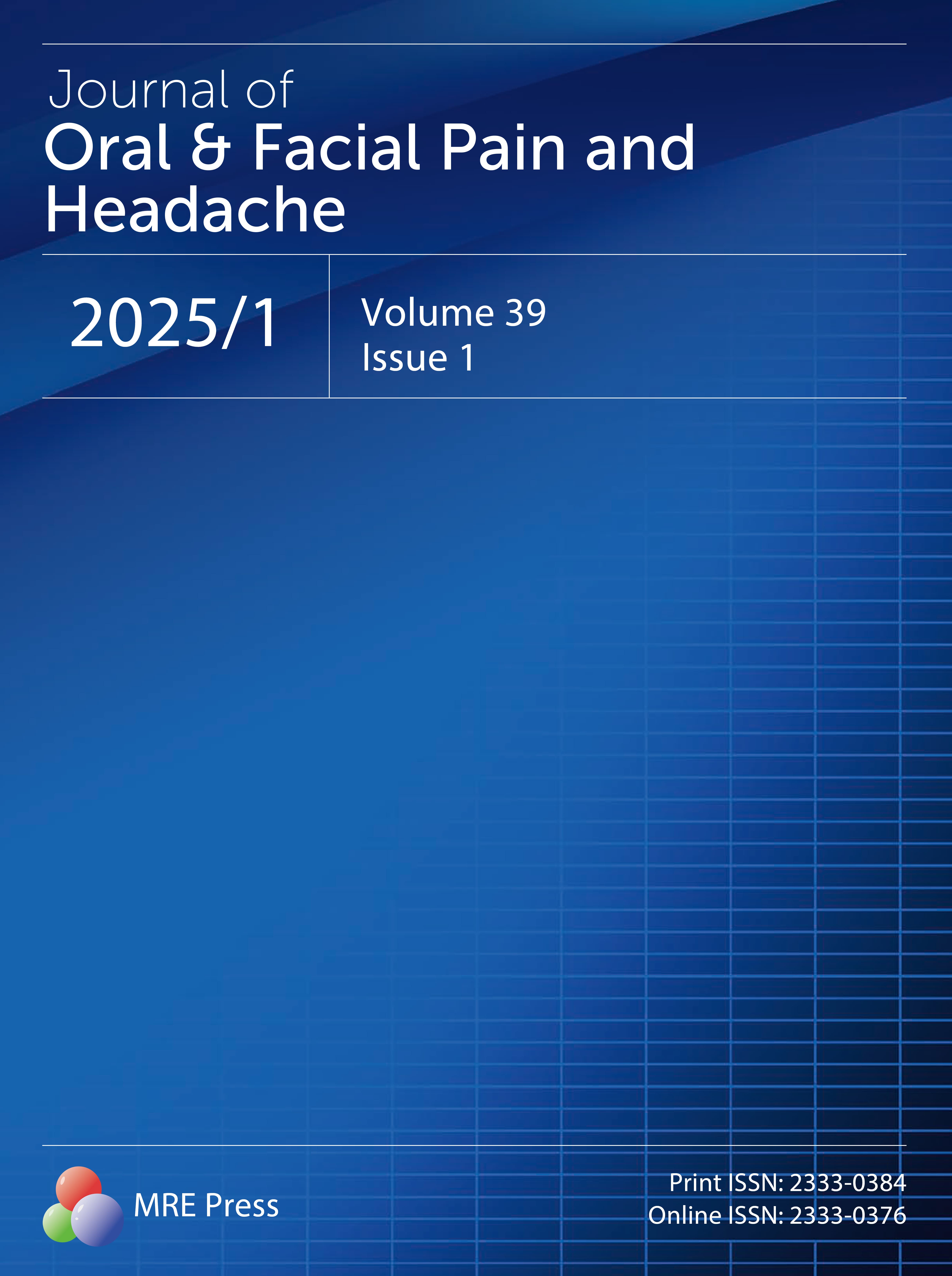Title
Author
DOI
Article Type
Special Issue
Volume
Issue
Article Menu
Export Article
More by Authors Links
Article Data
- Views 1021
- Dowloads 79
Journal of Oral & Facial Pain and Headache (OFPH) is published by MRE Press from Volume 38 lssue 1 (2024). Previous articles were published by another publisher on a subscription basis, and they are hosted by MRE Press on www.jofph.com as a courtesy and upon agreement with Journal of Oral & Facial Pain and Headache.
Original Research
Open AccessCase Report of a Posterior Disc Displacement Without and With Reduction
Case Report of a Posterior Disc Displacement Without and With Reduction
1Department of Oral Function, Section of Oral Kinesiology, Academic Centre for Dentistry Amsterdam (ACTA), Louwesweg 1 1066 EA Amsterdam, The Netherlands
*Corresponding Author(s): Frank Lobbezoo E-mail: f.lobbezoo@acta.nl
Abstract
This article presents the case of a patient with an acute posterior disc displacement without reduction (PDDWR), whose temporo-mandibular joint (TMJ) showed, after physiotherapeutic manipu-lation, the characteristics of a posterior disc displacement with reduction (PDDR). Opto-electronic condylar movement record-ings in both the PDDR state and the PDDWR state, and magnetic resonance imaging (MRI) scans of the TMJ in the PDDR state were carried out to document the case. The first 2 physiotherapeu-tic manipulations were initially successful in reducing the disc, but a few days later the joint showed a relapse to the PDDWR state. From the third manipulation on, now 12 months ago, the patient has been free of symptoms of the PDDWR state. Condylar move-ment traces of the joint in the PDDWR state indicated that the condyle was prevented from entering the fossa completely. The downward condylar movement deflections during the early phase of closing, recorded after the second manipulation, showed the reduction of the posteriorly displaced disc during closing. The movement recordings also showed that the PDDR could be elimi-nated by submaximal opening and closing movements. The MRI scans, taken after the third, successful manipulation, showed the disc to be in a normal position with respect to the condyle when the mouth was closed, and to be posteriorly displaced when the mouth was maximally opened. The case shows that manipulation techniques may successfully reverse an acute PDDWR into a PDDR. The technique of MRIs and condylar movement record-ings show promise in further unraveling the morphological and clinical features of posterior disc displacements.
Keywords
condylar movement recordings; internal derangement; magnetic resonance imaging; posterior disc displacement; temporomandibular joint
Cite and Share
James J. R. Huddleston Slater, Frank Lobbezoo, Nico Hofman, Machiel Naeije. Case Report of a Posterior Disc Displacement Without and With Reduction. Journal of Oral & Facial Pain and Headache. 2005. 19(4);337-342.
References
1. Farrar WB, McCarty WL. A Clinical Outline of Temporomandibular Joint Diagnosis and Treatment, ed 7. Montgomery, AL: Normandie Study Group for TMJ Dysfunction, 1982.
2. Obwegeser H, Aarnes K. Zur Luxation des Discus Articularis des Kiefergekenkes. Schweiz Monatsschr Zahnheilkd 1973;83:67–70.
3. Blankestijn J, Boering G. Posterior dislocation of the temporomandibular disc. Int J Oral Surg 1985;14:437–443.
4. Gallagher DM. Posterior dislocation of the temporomandibular joint meniscus: Report of 3 cases. J Am Dent Assoc 1986;113:411–415.
5. Engelke W. Die dorsale Diskusluxation, eine Rarität? Dtsch Z Mund Kiefer Gesichtschir 1990;14:86–89.
6. Westesson PL, Larheim TA, Tanaka H. Posterior disc displacement in the temporomandibular joint. J Oral Maxillofac Surg 1998;56:1266–1273.
7. Chossegros C, Cheynet F, Guyot L, Bellot-Samson V, Blanc JL. Posterior disk displacement of the TMJ: MRI evidence in two cases. Cranio 2001;19:289–293.
8. Nitzan DW. Temporomandibular joint “open lock” versus condylar dislocation: Signs and symptoms, imaging, treatment, and pathogenesis. J Oral Maxillofac Surg 2002;60:506–511.
9. Wise SW, Conway WF, Laskin DM. Temporomandibular joint clicking only on closure: Report of a case and explanation of the cause. J Oral Maxillofac Surg 1993;51:1272–1273.
10. Yoda T, Imai H, Shinjyo Y, Sakamoto I, Abe M, Enomoto S. Effect of arthrocentesis on TMJ disturbance of mouth closure with loud clicking: A preliminary study. Cranio 2002;20:18–22.
11. Naeije M, van der Weijden JJ, Megens CC. OKAS-3D: Optoelectronic jaw movement recording system with six degrees of freedom. Med Biol Eng Comput 1995;33:683–688.
12. Yatabe M, Zwijnenburg A, Megens CC, Naeije M. The kinematic center: A reference for condylar movements. J Dent Res 1995;74:1644–1648.
13. Naeije M, Huddleston Slater JJR, Lobbezoo F. Variation in movement traces of the kinematic center of the temporomandibular joint. J Orofac Pain 1999;13:121–127.
14. Kircos LT, Ortendahl DA, Mark AS, Arakawa M. Magnetic resonance imaging of the TMJ disc in asymptomatic volunteers. J Oral Maxillofac Surg 1987;45:852–854.
15. Barclay P, Hollender LG, Maravilla KR, Truelove EL. Comparison of clinical magnetic resonance imaging diagnosis in patients with disc displacement in the temporo-mandibular joint. Oral Surg Oral Med Oral Pathol Oral Radiol Endod 1999;88:37–43.
16. Huddleston Slater JR, Lobbezoo F, Chen Y-J, Naeije M. A comparative study between clinical and instrumental methods for the recognition of internal derangements with a clicking sound on condylar movement. J Orofac Pain 2004;18:138–147.
17. Larheim TA, Westesson PL, Sano T. Temporomandibular joint disk displacement: Comparison in asymptomatic volunteers and patients. Radiology 2001;218:428–432.

Abstracted / indexed in
Science Citation Index (SCI)
Science Citation Index Expanded (SCIE)
BIOSIS Previews
Scopus
Cumulative Index to Nursing and Allied Health Literature (CINAHL)
Submission Turnaround Time
Editorial review: 1 - 7 days
Peer review: 1 - 3 months
Publish Ahead of Print: within 2 months after being accepted
Notes: Your information is kept confidential throughout the review process.
Top
